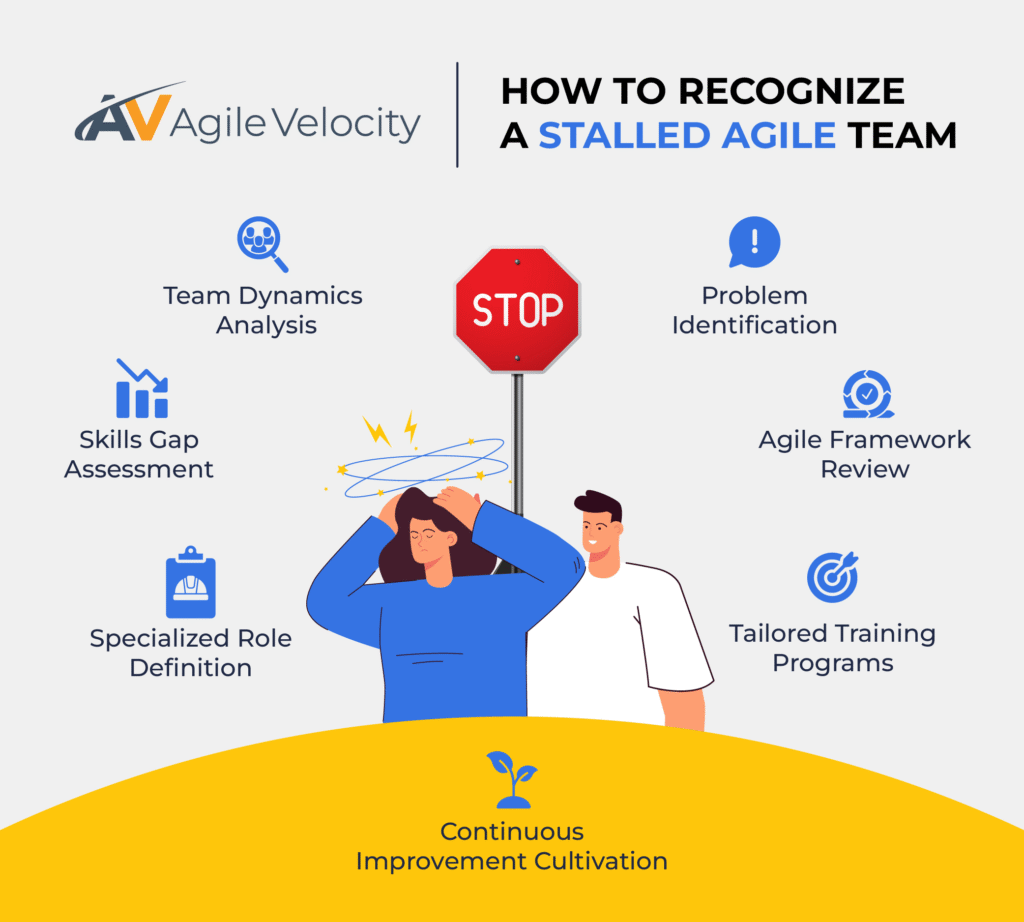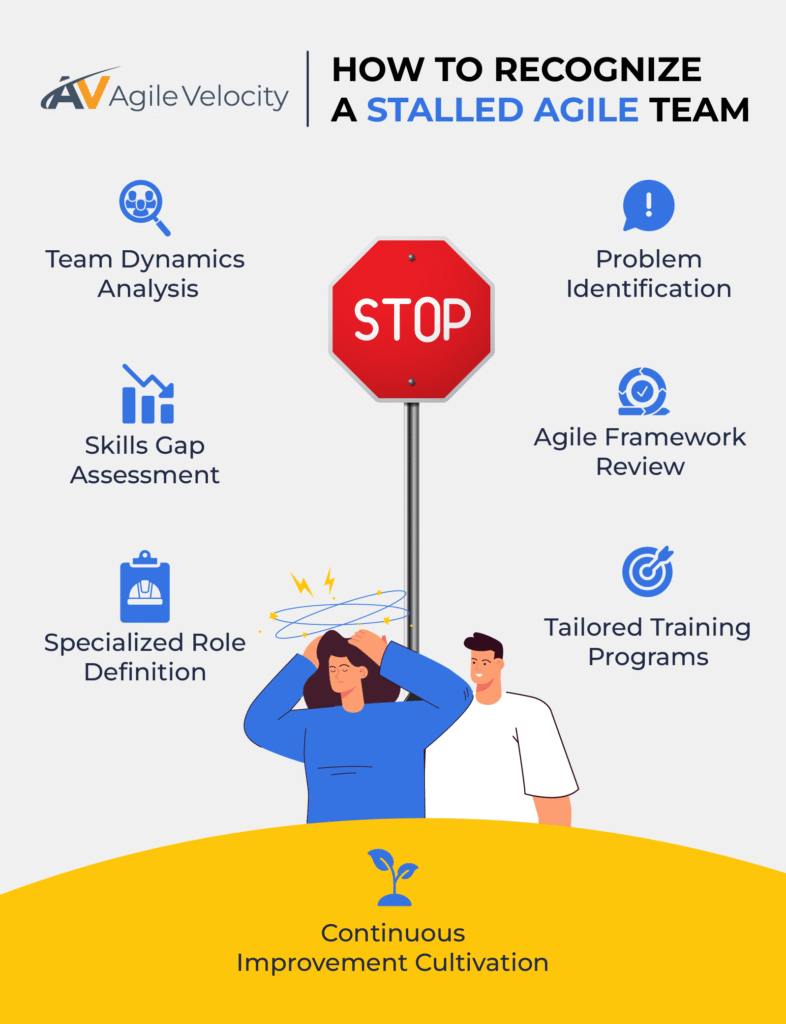Leading Agile teams come with unique challenges that often require expert guidance. Whether it’s streamlining communication, optimizing roles, or leveraging specialized tools, skill gaps can quietly disrupt performance, leading to inefficiencies and frustration. With tailored support and practical solutions, Agile teams can overcome these obstacles to work more cohesively and improve overall execution.
This article explores how skill gaps can impede Agile teams, why addressing these gaps is essential for success, and how organizations like Agile Velocity provide support through expertise and specialized services. From Agile staffing to training and coaching, Agile Velocity offers solutions designed to help organizations build high-performing, adaptable teams ready to thrive in today’s work environments. Let’s look at strategies to transform Agile teams and drive meaningful results.
Common Challenges Agile Teams Face
Agile teams are expected to adapt rapidly, deliver value in shorter cycles, and foster innovation. However, these goals can be challenging when misaligned expectations disrupt team dynamics. A lack of common and specialized skills can both lead to inefficiencies and prevent team members from fully embracing Agile methodologies. Without a shared understanding of roles and responsibilities, confusion arises—especially when collaboration within a Scrum Team or across functions falters, making it difficult for teams to maintain alignment and execute effectively.
One common challenge is duplicated efforts or overlooked tasks due to unclear roles and insufficient communication. When collaboration falters, productivity suffers as valuable time is spent resolving misunderstandings. Although the direct budgetary impact is hard to quantify, repeated inefficiencies can lower morale and erode confidence in Agile practices.
By understanding and addressing these challenges, teams can refine their approach and start realizing the benefits of Agile. Recognizing and bridging skill gaps is a vital step toward fostering a high-performing, collaborative, and efficient team environment.
The Impact of Skill Gaps on Agile Success
Skill gaps within Agile teams can cascade into challenges that hinder the achievement of core Agile objectives. Even minor deficiencies—such as a Scrum Master who is still honing facilitation abilities or a Product Owner who is learning how to effectively prioritize the backlog—can disrupt momentum and affect Sprint execution. These shortcomings may lead to poorly executed Scrum events, disorganized workflows, and missed opportunities for continuous improvement.
When teams are not equipped with the necessary expertise, it becomes difficult to maintain the iterative rhythm that is key to Agile. Instead of fostering adaptability and innovation, processes can become reactive, with teams scrambling to meet targets without a clear path forward. Over time, these inefficiencies not only delay deliverables but can also undermine confidence in Agile practices.
Skill imbalances can constrain creativity and limit collaboration. When expertise is concentrated in only a few individuals, bottlenecks are inevitable and bottlenecks limit productivity. This lack of diverse input can stifle open communication and trust, preventing the team from realizing its full potential. In larger initiatives—such as those involving frameworks like SAFe®—skill gaps can also hinder alignment between teams and strategic objectives.
Enhancing team performance by addressing skill gaps leads to higher efficiency, more robust collaboration, and a foundation for continuous improvement. This benefits both day-to-day delivery and long-term success in Agile transformation.
Signs Your Agile Teams May Be Stuck
Recognizing when an Agile team is struggling can be difficult, as signs may be subtle. However, certain patterns can indicate deeper issues:
- Difficulty in Planning: When skills are concentrated in one or two individuals, priority based planning becomes more difficult and focus can shift to filling available capacity.
- Inconsistent Sprint Completion: Teams that frequently fall short of meeting Sprint Goals may be affected by misaligned priorities or incomplete process adoption.
- Repeated Missed Deadlines: Regularly missing timelines may reflect skill shortages or communication hurdles.
- Challenges Scaling Agile Practices: Difficulties in scaling frameworks like SAFe or integrating Scrum and Kanban across multiple teams might point to readiness or knowledge gaps.
- Persistent Friction and Miscommunication: Frequent conflicts or poor role clarity can erode trust and stall progress.
- Declining Productivity and Growth: If a team continually revisits the same issues without improvement, it might be time to evaluate skills and processes.
Identifying these signs should prompt a review of team capabilities. Early and purposeful intervention can reinvigorate momentum, enhance collaboration, and foster sustainable progress.
How Skill Gaps Disrupt Agile Momentum
When Agile teams encounter skill gaps, the effects can ripple throughout the entire process. For example, if a Scrum Master is still developing key facilitation techniques or a Product Owner is unsure of effective backlog management, critical Agile events may suffer. Without the right expertise, events such as Sprint Planning, Reviews, and Retrospectives may lack focus and clarity. Instead of promoting a proactive, self-organizing team, processes can become reactive, straining the team’s ability to deliver value consistently.
In larger frameworks like SAFe, even a single gap can create ripple effects, slowing down overall progress and affecting strategic alignment. Addressing these gaps is essential to streamline workflows, boost team morale, and sustain progress over time.
Agile Velocity’s Approach to Bridging Skill Gaps
Agile Velocity emphasizes comprehensive support for overcoming obstacles that impede Agile performance. Rather than strictly beginning with formal in-depth assessments, their overall approach focuses on identifying key workflow challenges and gaps in collaboration. Once potential barriers are recognized, Agile Velocity works with organizations to design tailored action plans that address technical proficiency, cultural alignment, and leadership development. Through a combination of coaching, training, and hands-on support, they help teams refine Agile practices and lay the foundation for ongoing growth.
Agile Velocity also promotes an Agile mindset across organizations by emphasizing transparency, collaboration, and continuous improvement. Their services help teams develop approaches that adapt to evolving challenges while maintaining alignment with strategic objectives.
Agile Staffing: Building High-Performing Agile Teams
Staffing is another critical component in optimizing Agile execution. Agile Velocity’s Agile Staffing service is designed to match qualified professionals with organizations that need specialized skills. By assessing both technical expertise and cultural fit, they connect companies with pre-vetted Agile practitioners—including Scrum Masters, Product Owners, and Release Train Engineers—who can strengthen teams where gaps exist.
A well-structured selection and onboarding process ensures that new team members integrate smoothly, maintain productivity, and receive ongoing mentoring, which is vital for sustained success.
Overcoming Skill Gaps in Practice
Bridging skill gaps is not solely about recruiting new talent; it’s also about nurturing a supportive environment that fosters continuous growth. This process involves aligning leadership perspectives, ensuring that each team member understands how daily tasks relate to larger organizational goals, and maintaining clear communication on expectations and progress.
Hypothetical Illustration: A Growing Tech Company
Consider the example of a growing tech company that recently adopted Scrum and Kanban to better manage its software development initiatives. In this scenario, teams were enthusiastic about embracing Agile values, yet they encountered challenges common to any Agile transition. For instance, developers faced difficulties with Kanban Boards and managing Work In Progress (WIP) Limits, which contributed to cluttered workflows. At the same time, the Product Owner found it challenging to effectively prioritize the backlog, leaving the Scrum Team uncertain about which tasks to address first.
In response to these challenges, the company sought external support. By collaborating with an Agile-focused service provider, the organization received tailored solutions that are typical in many Agile transitions. These solutions included:
- Targeted Training: Specialized workshops covered the fundamentals of Scrum, effective Sprint Planning, and efficient use of Kanban Boards.
- Ongoing Coaching: An Agile coach provided dedicated one-on-one support to refine how the Product Owner organized and communicated tasks in the Product Backlog.
- Leadership Alignment: Managers received guidance on setting clear high-level objectives and establishing feedback loops, ensuring that initiatives aligned with broader strategic goals.
- Cultural Reinforcement: Through sessions promoting transparency and open feedback, employees became more comfortable raising concerns, suggesting improvements, and experimenting with new ideas.
Over a few iterations, this comprehensive approach led to fewer roadblocks, improved Sprint predictability, and enhanced collaboration across departments. With this momentum, the company went on to introduce structured PI (Planning Interval) Objectives to support larger planning cycles.
Beyond Staffing: Comprehensive Support for Agile Teams
While filling open positions can address immediate gaps, organizations also often need broader guidance for lasting Agile success. Agile Velocity’s suite of services is designed to provide a multi-layered approach to Agile adoption and continuous improvement.
Agile Coaching and Transformation Support
Agile coaching connects teams with experienced professionals who help cultivate a culture of responsibility, support, and innovation. Coaches work with Scrum Masters, Product Owners, and other team members to refine Agile practices and ensure that methods align with core principles.
Agile Training for Lasting Skill Development
In addition to coaching, Agile training workshops provide teams at every stage with opportunities to develop their Agile expertise. These interactive sessions cover foundational and advanced techniques aimed at improving communication and refining day-to-day practices.
Lean Portfolio Management: Aligning Strategy and Execution
Lean Portfolio Management bridges the gap between strategic priorities and daily activities. By integrating Lean and Agile methodologies, organizations gain enhanced clarity in resource allocation and can respond more swiftly to changing business demands.
Path to Agility® Navigator: A Clear Path to Agile Transformation
Effective Agile Transformation requires possessing a clear view of the current state, outlining future objectives, and understanding the challenges in between. Path to Agility® Navigator is one tool that helps leaders map and track their Agile transformation journey. This resource allows teams to visualize progress, identify obstacles, and determine actionable next steps in the transformation process.
By centralizing progress tracking with tools like the Path to Agility® Navigator, leaders can evaluate team capabilities against strategic objectives and target specific areas for improvement with greater precision.
Return to Office Events and AI Solutions: Supporting a Dynamic Workplace
In today’s rapidly evolving work environment, skill gaps can also emerge as organizations shift between remote, hybrid, or office-based work. Agile Velocity’s Return to Office Events offer structured sessions that recalibrate team dynamics, realign communication protocols, and rebuild personal connections that may have diminished during remote work. In a similar vein, the use of integrated AI Solutions can provide insights into resource allocation, automate workflows, and reduce human error. However, these technological advantages are best realized when teams are well-prepared and trained in their use.
Driving Long-Term Success with Holistic Support
Sustaining Agile success entails more than short-term fixes – it requires nurturing an environment that embodies an Agile mindset marked by transparency, robust collaboration, and regular adaptation. Incorporating practices such as DevOps further unifies development and operations, enabling accelerated iteration and smoother delivery cycles.
Steps to Maintain Momentum

Even following initial improvements, organizations must continually nurture the Agile process to prevent skill gaps from reemerging. Strategies include:
- Regular Skill Evaluations: Periodically review individual and team competencies to stay ahead of emerging gaps.
- Continuous Learning Opportunities: Ongoing workshops, return-to-office events, and group discussions help keep teams up-to-date on Agile practices and new technologies.
- Shared Accountability: Encourage a culture where everyone—from top executives to individual contributors—is responsible for the success of Agile practices.
- Visual Progress Tracking: Tools like the Path to Agility® Navigator help keep goals visible and progress measurable.
- Encouraging Experimentation: Foster an environment open to testing new ideas and making iterative changes that contribute to long-term efficiency and improvement.
Charting a Course for Sustainable Agile Success
Skill gaps in Agile teams can remain hidden at first, subtly impeding progress and diminishing morale. Yet, these challenges also provide an opportunity for significant growth. By actively identifying and addressing these gaps—through comprehensive approaches that include targeted training, ongoing coaching, leadership alignment, and cultural reinforcement—organizations can unlock a greater level of potential. Agile Velocity’s commitment to offering adaptable and supportive solutions illustrates how teams can evolve, leading to more consistent collaboration, streamlined processes, and improved performance.
Take the first proactive step toward a stronger Agile transformation. Explore how partnering with experts can equip your teams with the necessary support, insights, and resources to remain competitive and responsive in today’s ever-changing business landscape.





